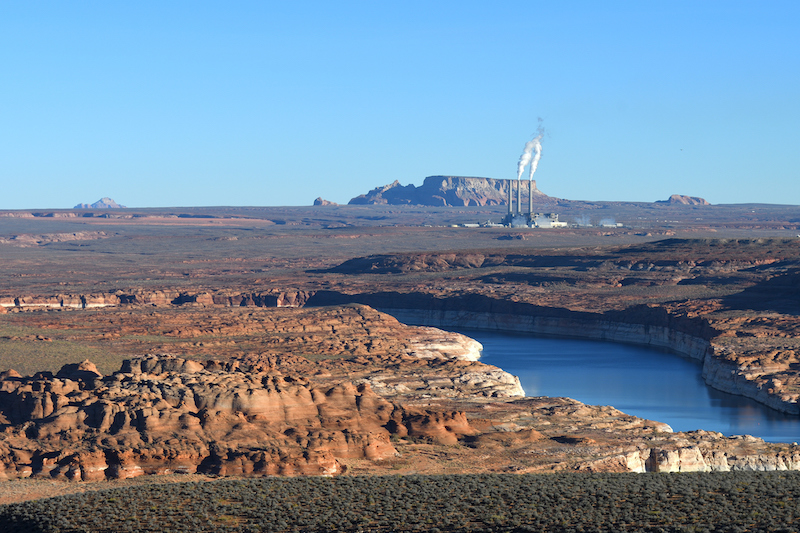
If the U.S. Congress fails to act on climate change, it should empower Indian tribes to protect their members.
Just last year, residents of the small community of Newtok, Alaska—home to approximately 380 Yup’ik Alaska Native people—packed up their belongings and moved away. As a result of climate change, the sea was slowly but surely eating at the melting permafrost underlying the town. Houses and infrastructure had been lost. The villagers had no choice but to leave their homes forever.
Two thousand miles to the south of Newtok, members of the Yurok Tribe are struggling to maintain their ancient fishing way of life on the Klamath River. The fish native to the Klamath, like all native fish of the Western United States, are struggling to survive as climate change ravages their ocean homes and destroys their spawning grounds in western rivers. In 2002 alone, at least 34,000 native fish perished in the Klamath, an event so traumatic for the Yurok and other regional tribes that it still looms large in their collective consciousness nearly 20 years later.
Meanwhile, tribal homes, property, and resources around the West have been permanently destroyed as a result of the ever-increasing number of megafires. For example, in 2015, the Colville Tribes of Eastern Washington lost over 200,000 acres of their 1.4 million acre reservation, nearly 15 percent of their entire land base.
Further south on the Navajo Reservation, where a full third of all tribal members lack running water and sewage systems, water shortages caused by climate change are destroying the Navajo Nation’s livestock-raising tradition, which has been passed down for generations.
These are just a few of the myriad examples demonstrating that, just as other people of color are unjustly endangered by a changing climate, the laws and policies in the United States have caused climate change to burden American Indians disproportionally.
Applying racist legal institutions and policies to Indian tribes is particularly egregious because the federal government has undertaken a trust responsibility—paid for with billions of acres of Indigenous lands—to protect tribal people, rights, and resources. The United States’ failure to fulfill this trust responsibility leaves tribal people particularly vulnerable to a menace that is largely not of their making.
The question here is whether tribes have the power—at least on their reservations—to step into the leadership vacuum the United States has created and begin to do their part to control runaway climate change.
At the outset, the question is not an academic one. Approximately 138 million acres of land are located within Indian reservations, with about 56.2 million acres held in trust by the United States for the benefit of tribes and their members. Those lands include approximately 30 percent of all western coal deposits, a disproportionate number of all power generation facilities—including coal-powered plants—and some of the richest oil and gas fields in Oklahoma and throughout the United States. Tribes’ ability—and inability—to control activities on these lands and to wield control over these resources is inextricably intertwined with the broader climate challenges tribes face today.
American Indian tribes are “unique aggregations possessing attributes of sovereignty over both their members and their territory.” As a result, there is little question that tribes could move to control both climate change-causing activities by tribal members and by other conduct taking place on lands owned by the tribes and their members.
Most of the carbon-emitting activities on Indian reservations, however, undoubtedly are taking place on lands held by non-Indians in fee simple ownership. The U.S. Supreme Court has found that, in the absence of congressional authorization, tribes generally lack the authority to regulate non-Indian conduct on these lands.
That rule—derived from the Court’s decision in Montana v. United States—is subject to two exceptions.
First, a tribe may regulate “the activities of nonmembers who enter consensual relationships with the tribe or its members, through commercial dealing, contracts, leases, or other arrangements.”
Second, tribes may regulate non-Indian conduct that “threatens or has some direct effect” on tribal political integrity, economic security, or health and welfare. Although the so-called first Montana exception may hold promise to help curb carbon emissions in certain circumstances, I focus in this essay on the second exception.
On its face, this second exception is seemingly broad. But in recent years, the Supreme Court has interpreted it extremely narrowly. In fact, a divided Court has gone so far as to include dicta explaining that such conduct “must do more than injure the tribe; it must ‘imperil the subsistence’ of the tribal community.” The Court has also asserted that the “elevated threshold for application of the second Montana exception suggests that tribal power must be necessary to avert catastrophic consequences.”
Notwithstanding the dubious nature of the Court’s dicta, it is beyond doubt that the environmental disasters already taking place within Indigenous communities meet even that extremely cramped reading of the second Montana exception. It seems difficult to argue that sea-level rise at Newtok or the megafires at Colville have not had “catastrophic consequences” for those communities. Likewise, there is little question that the destruction of the Klamath River fishery and the implosion of the Navajo Nation’s livestock industry are “imperiling the subsistence” of tribe members.
Nonetheless, difficult legal questions remain.
Most insidious is that tribes may run up against issues of causation. A court might require a direct nexus between the alleged climate change-causing activity under regulatory consideration and the climate disaster a tribe is seeking to avoid. Such a standard is impossible to meet, even for those tribes that are currently experiencing catastrophic climate disasters.
Related to causation is redressability, or whether the regulation of any single polluter would effectively remedy the “catastrophic consequences” that climate change causes for a tribe.
Even more difficult questions arise on reservations where obvious climate disasters are not yet occurring. At these reservations, emitters can argue that until the literal eve of a climate disaster, climate change is not “imperiling the subsistence” of the tribe.
As national politics and lawsuits against emitters based on the public nuisance doctrine demonstrate, the unique nature of climate change lends itself to these paralyzing arguments.
Unlike other atmospheric pollution, where harm can often be traced to a single emitter, climate change is caused by the cumulative effect of all emissions. The result is a paradox that some courts and lawmakers seize upon to prevent action on climate change—although every emitter is contributing to climate change, the damage of climate change can be traced to no particular party.
Similarly, although the reduction of greenhouse gas emission by any single emitter reduces the inevitability of climate change, single emitters cannot redress the harms of climate change on their own. Furthermore, the scientific community has long understood that climate change has lags and largely unpredictable feedback loops. As a result, a climate disaster is not an opportunity to reverse course but rather the signal that the first domino has fallen.
In short, it is impossible for a tribe to prove that some particular emission will imminently cause a climate disaster on its reservation—and, even if a tribe could prove direct causation, it would be too late to act.
All of this leads to the inexorable conclusion that it is morally repugnant for the United States to victimize tribes by doing nothing about climate change while simultaneously rendering them powerless to do anything about it themselves.
When tribes object to regulatory failures resulting in climate catastrophes, or seek to regulate climate changing activities on their own, the legal standard of proof should be fundamentally different than in the public nuisance context because of the trust responsibility the United States’ government owes to tribes.
More to the point, providing only an ex post approach to remedying the harms of climate change would undermine the entire premise of regulation, which is to prevent harm before it happens. Supreme Court precedent should not be read in a way that yields the absurd result that it is illegal for a tribe to regulate climate emissions until after regulation would be moot.
Instead, the guiding light of emissions regulation must be what is reasonable. Climate change regulation cannot be thought of in terms of individual emissions—rather, regulators must consider its efficacy given the totality of the circumstances.
Climate change writ large threatens “catastrophic consequences” that “imperils the subsistence” of tribal communities everywhere. If an activity can be reasonably said to be contributing to climate change, then its regulation would by definition avert—even if only slightly—the harm that tribes and their members experience.
Ultimately, addressing climate change is a moral imperative. It is not a burden that tribes should have to shoulder on their own. As the organ of the federal government that has plenary authority in Indian affairs, the U.S. Congress should fulfill the United States’ trust responsibility and take meaningful action to fix the climate crisis before it grows entirely out of control.
In the absence of such action, Congress should expressly empower tribes by reaffirming tribal climate regulatory authority much in the same way it already has for clean air and water. At the very least, the Supreme Court should respect Congress’s policy of tribal self-determination and affirm the sovereign right for American Indian tribes to protect their homelands from climate change.
This essay is part of a series entitled Native Peoples, Tribal Sovereignty, and Regulation.




